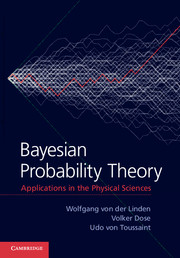Book contents
- Frontmatter
- Contents
- Preface
- PART I INTRODUCTION
- PART II ASSIGNING PROBABILITIES
- PART III PARAMETER ESTIMATION
- PART IV TESTING HYPOTHESES
- 17 The Bayesian way
- 18 The frequentist approach
- 19 Sampling distributions
- 20 Comparison of Bayesian and frequentist hypothesis tests
- PART V REAL-WORLD APPLICATIONS
- PART VI PROBABILISTIC NUMERICAL TECHNIQUES
- Appendix A Mathematical compendium
- Appendix B Selected proofs and derivations
- Appendix C Symbols and notation
- References
- Index
18 - The frequentist approach
from PART IV - TESTING HYPOTHESES
Published online by Cambridge University Press: 05 July 2014
- Frontmatter
- Contents
- Preface
- PART I INTRODUCTION
- PART II ASSIGNING PROBABILITIES
- PART III PARAMETER ESTIMATION
- PART IV TESTING HYPOTHESES
- 17 The Bayesian way
- 18 The frequentist approach
- 19 Sampling distributions
- 20 Comparison of Bayesian and frequentist hypothesis tests
- PART V REAL-WORLD APPLICATIONS
- PART VI PROBABILISTIC NUMERICAL TECHNIQUES
- Appendix A Mathematical compendium
- Appendix B Selected proofs and derivations
- Appendix C Symbols and notation
- References
- Index
Summary
As outlined earlier, in the frequentist's reasoning there is no such thing as a probability of or for a hypothesis, as the latter is not a random variable. The basic concept of hypothesis tests in the frequentist theory has been introduced briefly in Section 2.3 [p. 28]. The key idea is fairly simple, though not entirely obvious, and we will start out with a simple and transparent example.
Introduction
Let us consider a basic example of quality control. A manufacturer sells components of electronic devices. In order to verify that his production line is working properly, he or she periodically takes samples and checks whether all electronic features are correct. If this is the case the component is called intact, otherwise defect. Let the number of elements per test (sample size) be N and the number of defect components be denoted by n. By virtue of an agreement with the clients, the percentage of defective components should not exceed a given threshold q. For the manufacturer, the optimal state of his production line is if the mean number of defective parts in the sample is μ = qN. If there are more defective components, the manufacturer would have to pay a penalty and if there are less, the production line could be modified in one way or another to become more cost-effective.
- Type
- Chapter
- Information
- Bayesian Probability TheoryApplications in the Physical Sciences, pp. 276 - 283Publisher: Cambridge University PressPrint publication year: 2014

